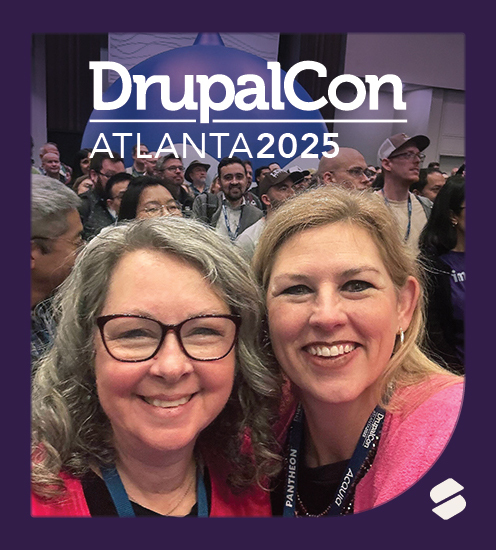Reflections from DrupalCon Atlanta 2025

Innovation, Inclusion, and the Future of Open Source
By Beth Gunter, with insights from Sheila Burkett and George Agathos
Attending my second DrupalCon, hosted in Atlanta this year, reminded me why I love the Drupal community so much. DrupalCon isn’t just about the keynotes or the technical sessions, although those were fantastic. The real magic is in the conversations—over coffee, between sessions, and during those late-night chats where ideas collide and possibilities open up.
Throughout this year’s conference, a few powerful themes surfaced across industries, roles, and regions. Spry Digital sent a few of us to take it all in. I’m excited to share my takeaways and those of my colleagues Sheila Burkett and George Agathos, who brought their unique perspectives to the experience.
AI: From Curiosity to Capability
At last year’s DrupalCon, the buzz around AI centered around questions like “How will this affect us?” and “Will it stay open?” and “Who’s investing in it?” Fast forward to this year, and the conversation has shifted from speculation to application. AI is still very much a hot topic—and it’s only gaining momentum.
During the Higher Ed Summit, we heard from Tina Miller of Arizona State University, who gave us an incredible look into how ASU is taking innovation to heart. They’re not just exploring the possibilities—they’re leading from the front. One of the more mind-blowing examples: ASU’s exploration of creating AI personas by uploading extensive documents, publications, and historical data from key figures, such as deans and faculty leaders. The result: When the marketing or communications team needs to ask, “What would Dean X say about this?” they can ask the AI version of the dean. And it responds in a way that’s shockingly aligned with what the real-life person would say.
Let that sink in.
This was a clear indication that AI is not only becoming more integrated, but that its future impact on universities, businesses, and agencies is being taken seriously—and creatively.
Tools That Empower: Layout Builder, Recipes, and More
Another topic that sparked a lot of chatter was around Layout Builder, Experience Builder, and good ol’ Paragraphs. Which is “easier”? Which is “better”? What’s the most intuitive for content teams?
The excitement around the new Experience Builder was palpable. There’s a lot of hope that it will continue to streamline workflows and make the lives of designers and developers a bit easier (and, dare I say, maybe even more fun?!). Tools that reduce complexity and empower teams to be more agile are always welcome – and this one looks like it might live up to the hype.
With the latest Drupal release and the introduction of DrupalShot last year, “recipes” also became a trending term. Not the kind you cook with, but the kind that helps standardize and simplify the way we build with Drupal. These programming recipes are a huge step toward reducing friction and increasing consistency, which is especially helpful for teams managing large sites or multisite environments.
Higher Ed and the Current Climate
At the Higher Ed Summit, another thread kept resurfacing: the implications of the current U.S. administration on digital content, compliance, and funding. It’s clear this is on everyone’s mind. Some universities are taking a proactive stance, locking down or even removing content. Others are in “wait and see” mode, trying to anticipate what’s to come. With 11 months and three weeks until the next North American DrupalCon (but who’s counting?), we can expect this conversation to evolve – just as everything else.
Community Vision: Sheila’s Call to Action
Sheila came away from DrupalCon 2025 with a renewed energy around Drupal’s unique position in the CMS space. As she put it, “There’s a clear and compelling vision taking shape—one where Drupal boldly differentiates itself from WordPress, not just as an alternative, but as the superior platform for organizations that demand flexibility, scalability, and security.”
She also sees a major opportunity in the possibility of a theme marketplace—something we talk about at Spry. It’s an area ripe for innovation, and one where we contribute by creating elegant, user-first designs that make transformation more accessible for all.
But what really resonated from Sheila’s perspective was the urgency of growing and diversifying the talent pipeline. She talked about the need to look beyond traditional paths into tech—to embrace non-traditional programs, apprenticeships, and training opportunities that bring in new voices, especially those historically left out of the conversation. This is a core belief at Spry Digital: Our strength lies in whom we include and how we support their growth.
A Return to Simplicity and Strength: George’s Perspective
For George, Drupalcon Atlanta felt like a return to form. He reflected on how the latest Drupal release is helping lower barriers for new users, a move that reminded him of the early days of Drupal, when it felt accessible and exciting.
He shared three big takeaways:
- Community Strength: The enduring strength of the Drupal community is a major asset, especially in uncertain times. In a world where everything is an upsell or sales pitch, Drupal remains a breath of fresh air.
- Accessibility: Lowering barriers for new users is crucial to attracting the next generation of developers and site builders.
- Future Potential: Drupal’s AI features and open-source nature provide a unique opportunity to appeal to young creators at a time when every creative tool is becoming monetized.
Why I Keep Coming Back
Even with all the talk of AI, automation and cutting-edge tools, what stuck with me most was the human side of DrupalCon. The laughter. The shared meals. The sense that we’re all building something bigger than ourselves.
The Drupal community continues to feel like home: welcoming, vibrant, and deeply collaborative. As I walked away from Atlanta this year, I felt not only more connected to the people in this space, but more hopeful about the work we’re doing and where it’s going.
The future of digital is being built in rooms like these—with code, with conversation, and with care.
See you next year, when the AI might be smarter, but the community will be just as strong.



